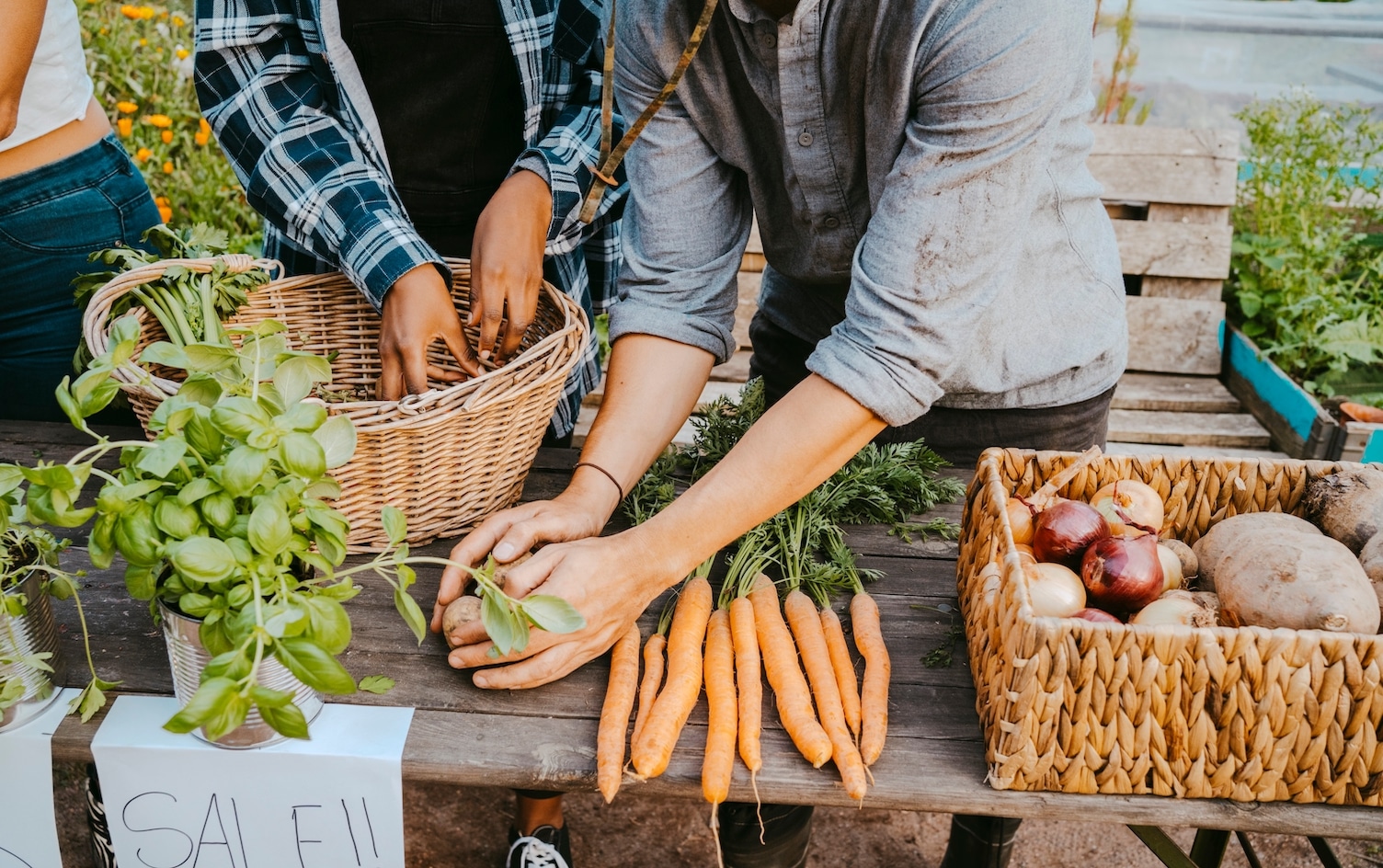It’s mealtime. How much planning goes into what you’re eating? Thinking about what’s in your food makes it easier to reach your wellness goals. That’s because nutrition matters, but where your food comes from does, too. Sustainable eating has a lot of benefits — for yourself and the environment — and it can lead to greater health all around.
How Can a Sustainable Diet Make an Environmental Impact?
What you eat affects the planet, and choosing a sustainable diet can lead to healthier soil, water, and air. Think of picking sustainable foods like voting with your food dollars. Buying these foods tells food producers what you want. It also encourages them to focus more on sustainable food production and eco-friendly practices.
When you choose organic or sustainable fruits, vegetables, whole grains, nuts, and sustainably raised or harvested meats, you’re helping reduce harm to the environment.
Growing food sustainably means using less water, energy, and chemicals. Sustainable food producers recycle waste or use renewable energy. You’ll see them contributing less to soil erosion and water pollution. Some agriculture practices can even create important wildlife habitats.
9 Tips for Developing Sustainable Eating Habits
Shifting to sustainable eating habits has its challenges, but it’s a fulfilling goal. The first step is to cultivate the right mindset. Think of it like a fitness routine you start after an injury. You don’t launch right into heavy-hitter exercises. You start slow, building your stamina and creating the strength and flexibility you want.
As you prime your mindset, you’ll look at foods differently and want to learn more about where they came from and how they were grown. Before long, you’ll be a pro at eating sustainably. Here are nine tips to help you make sustainable choices.
1. Prioritize plants in your diet
Eating more plants helps you support a healthier style of agriculture. According to numerous studies, a diet rich in plant-based foods is less harmful to the Earth.
Keeping livestock and other animals raised for meat takes a lot of resources. Think: water, food, land, and even medicine. Many grains, vegetables, fruits, and nuts require a lot less of these resources. This means producers can grow more plant-based foods with fewer inputs.
Sustainable nutrition is all about producing (and eating) eco-friendly foods to stay healthy and avoid harming the environment.
2. Consider growing your own food
Whether you have a small yard, balcony, or simply a sunny spot near the window, you can grow some delicious fruits and vegetables. It’s easy to bring in a planter box that you can fill with nutrient-rich topsoil. Or, if you want to flex your DIY muscles, you could build one to make it custom-fit the space.
Growing your own food has many benefits. You can take pride in nurturing something. You also feel good knowing the fruits and vegetables you eat are homegrown and pesticide-free. Sustainable food production can be as local as your backyard or balcony.
3. Stock up on local and seasonal goods
Not everyone has the time to grow food at home. That’s okay! When you shop for food, try to look for in-season produce first. The United States Department of Agriculture has a handy guide to help you know what’s at its peak freshness throughout the year. Some regions have different growing seasons, so you might see differences depending on where you live.
You can also search for local farmers markets. These markets have locally grown foods for sale, and you can find a huge variety of seasonal fruits, vegetables, and other foods.
Shopping at farmers markets also gives you the chance to chat with local farmers. You might hear how they put sustainable farming practices into action to feed people and earn a living.
4. Try red meat replacements
Studies have shown that meat-based diets aren’t great for the planet. For example, raising livestock can lead to:
- Poor-quality dirt
- Bare ground or deforestation
- More greenhouse gas emissions
When you switch out your red meat food choices, consider alternatives like sustainably harvested fish or pasture-raised chicken. These animal proteins are good for you and don’t lead to intensive land grazing. You might also try savory vegetarian or vegan alternatives, such as:
- Chopped mushrooms
- Tofu
- Tempeh
These plant-based proteins give you a meaty texture and umami taste without the meat.

5. Consume more sustainable types of seafood
Fishing also causes an environmental impact. Overfishing can destroy many fish populations, and some may never recover. When buying seafood, look for the store’s harvesting sources and check for certifications like these:
Seafood has different health benefits than red meat, but the type of fish and how it’s prepared make a difference. Do you find yourself eyeing those battered fish packages in the grocery store? It’s best to enjoy fried fish in moderation because it can increase the risk of clogged arteries and stroke. Instead, prepare fish yourself.
Here are some tasty seasonings to consider:
- Lemon juice
- Herb marinades
- Paprika
- Dry mustard
- Garlic
- Olive oil
- Toasted nuts
Also, some seafood has higher amounts of mercury, such as orange roughy, king mackerel and bigeye tuna, which is important to avoid if you are pregnant or breastfeeding. Other individuals should limit themselves to consuming these types of seafood once a week. Fish low in mercury include: salmon, cod, haddock, catfish, whitefish, and sole, and it is recommended to enjoy these types of fish several times a week.
6. Buy foods with environmentally friendly packaging
Single-use plastics and foam are a big problem, causing ocean pollution and landfill dumping. Many of these products don’t break down. Others stick around for hundreds of years and release harmful chemicals. This food packaging also hurts ocean wildlife that accidentally eats microplastics.
Plastic packaging chemicals can also affect your endocrine system, hormones, and other body cells.
Here are some ways to help the planet and your health:
- Do your best to avoid food packaged in plastic — whether at the grocery store or as restaurant takeout containers.
- Choose packaging without plastic parts.
- Skip the rolls of plastic produce bags — use your reusable bags or bring small mesh bags that are easy to see through.
You could also check with local organizations about grassroots actions. They could have opportunities to petition local or state governments to ban different types of plastics. These organizations might also petition food companies to reduce plastics in packaging.
7. Use food scraps for composting
Depending on where you live, your city or town might have a food scraps collection service. These programs keep a lot of food waste out of landfills and cut down on methane gas that’s produced as food breaks down. According to the Environmental Protection Agency (EPA), almost 60% of the methane released from landfills comes from the food people throw away.
If your region doesn’t have a food scrap program, create your own compost at home. You can use this organic matter to enrich your planter boxes or build up the health of your yard. Using sustainable food practices, you can generate compost to recycle into next season’s produce.
What if you don’t have a yard? There are many composting food systems with low to no odor that you can set up in your kitchen. Brands like EarthHero, SCD Probiotics, and Lomi have indoor composters that fit any size home.
8. Diversify your diet
Even if you’ve shifted to plant-based foods, you should keep your diet diverse to get all the macro and micronutrients you need.
To broaden your diet and focus on sustainable eating, choose seasonal foods. For example, many root vegetables are ready to eat during summer and fall, while stone fruits and berries tend to ripen in late spring to summer. Of course, where you live can affect what grows. Some places can have several growing seasons each year, while others — especially northern regions — have one.
When you diversify your eating habits, you also help your gut bacteria. Gut health improves with healthy food. These nutrients help your good bacteria protect the gastrointestinal tract from bad bacteria and other pathogens.
Plenty of color also leads to a naturally diverse and greener diet that helps your body stay strong:
- Purple and blue foods contain anthocyanin and polyphenol nutrients to boost your immune system, brain health, and mood.
- Red foods have anthocyanins and red carotenoids for calming inflammation and supporting your immune health.
- Orange and yellow foods are full of carotenoids and lutein to support your eye and gut health.
- Green foods have vitamin K, folate, and other micronutrients to help improve your cardiovascular system.
9. Reduce food waste through meal plans
Sometimes, you buy too much food and can’t eat it all before it spoils. Or, your food prep leads to more discards than you expected. Instead of dealing with food waste, work to prevent it. Meal plans are a good way to keep your eating habits exciting while only buying or making what you need.
With the MyFitnessPal app, your food insights are all in one place. Meal planning lets you tailor your meals to fit any dietary or calorie restrictions. Plus, you can reduce your time buying groceries and still come home with nutritious foods to last the week.
Find delicious recipes in the app and plan what you’ll eat each day of the week. Any leftovers can become new sustainable meals with minimal prep time.
Discover Our Healthy and Eco-Friendly Eat Green Plan
Not sure how to get started with sustainability and food? Tip: Use the Eat Green Plan in the MyFitnessPal app. It will teach you more about eating sustainably, plus offer recipes and tips for lowering your carbon footprint. We’re here for you and the planet, so let’s get healthy together.






